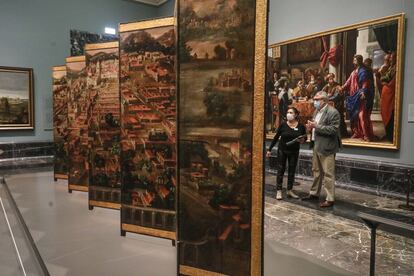On one side, life flows. Children chase a kite, some clergymen stroll and, off the trail, there is a bullfighting of heifers. In the city, from a bird's eye view, you can even sense the viceroy, in his car, recognizable by the team of six mules. On the other side of the screen, however, war breaks out. Soldiers and horses huddle together, arrows fly, swords clash, and heroism mixes with death, under the gaze of Cortés and Moctezuma. Because the last work invited to the Prado Museum tells two stories at the same time, one on each side:
Screen of the Conquest of Mexico and The Very Noble and Loyal City of Mexico,
made around 1675-1692 and whose author is unknown.
His story, narrated in 10 canvases painted on both sides and mounted on a wooden structure, offers an example of New Spain art; The screen comes from a private collection and will be in the gallery until September 26. It is exhibited within the framework of the initiative
The Guest Work
,
sponsored by the Fundación Amigos del Museo del Prado to exhibit “unique pieces that complement its collection”. Then it will be part of the
Tornaviaje
exhibition
, which the art gallery planned for last year and the pandemic postponed to this fall.
"The Spanish public is not so familiar with this type of works from America, nor with painted screens," said the director of the Prado, Miguel Falomir, at the presentation on Tuesday. And he added that the function of these screens was often social: "They were opened in a meeting to invite debate on the issues they represented." Hence, basically, the talk held before the work also served as a tribute to its past.
A beam of the screen, then, enters the conquest of Tenochtitlán, capital of the Aztec empire, which surrendered to the Spanish troops on August 13, 1521. The dark tints follow different phases of the war, with events that in reality They occupied two years and several places, and "offers the vision of the conquerors and their Creole descendants," according to the museum.
As examples, Moctezuma's reception of Cortés uses brighter colors, while the victory of the indigenous people in the so-called
sad night
is more somber.
In addition, the canvases identify the main indigenous characters with their names, a need that the author did not feel with the Spanish.
Miguel Falomir, director of the Prado, during the presentation of the screen this Tuesday.
What the work did require was an extensive restoration, lasting eight months, as explained by its manager, María Álvarez Garcillán. "Its state of conservation was not very good," he confessed.
"The work reflects the ideology of the Creole elites of the capital of New Spain and visualizes their relationship with a Hispanic monarchy to which they owed political fidelity and the origin of their faith, but also the pride and uniqueness of an American reality that would crystallize more than a century later in the process of independence ", sums up the note from the gallery. After all, the screen was made “as an object of ostentation and power”. Thus, the other face shows a peaceful Mexico City, after the conquest. 66 relevant buildings are identified, while the indigenous suburbs appear “minimized”, explained Falomir. The director clarified that there are about 10 similar screens, probably from the same workshop, and that another two even reflect the same episodes. This one, however, has a unique quirk:the portrait of the city not only shows its buildings. Streets and squares are populated with human beings. And of life.

